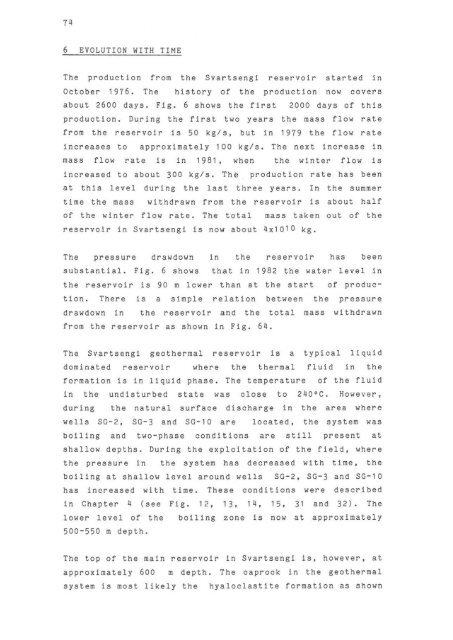temperature and pressure in the svartsengi ... - Orkustofnun
temperature and pressure in the svartsengi ... - Orkustofnun
temperature and pressure in the svartsengi ... - Orkustofnun
You also want an ePaper? Increase the reach of your titles
YUMPU automatically turns print PDFs into web optimized ePapers that Google loves.
7~6 EVOLUTION WITH TIMEThe production from <strong>the</strong> Svartsengi reservoir started <strong>in</strong>October 1976. The history of <strong>the</strong> productIon now coversabout 2600 days. Fig. 6 shows <strong>the</strong> first 2000 days of thisproductIon. Dur<strong>in</strong>g <strong>the</strong> first two years <strong>the</strong> mass flow ratefrom <strong>the</strong> reservoir Is 50 kg/s, but In 1979 <strong>the</strong> flow rate<strong>in</strong>creases to approximately 100 kg/so The next <strong>in</strong>crease <strong>in</strong>mass flow rate Is <strong>in</strong> 1981, when <strong>the</strong> w<strong>in</strong>ter flow Is<strong>in</strong>creased to about 300 kg/so The productIon rate has beenat this level dur<strong>in</strong>g <strong>the</strong> last three years. In <strong>the</strong> summertime <strong>the</strong> mass withdrawn from <strong>the</strong> reservoir Is about halfof <strong>the</strong> w<strong>in</strong>ter flow rate. The total mass taken out of <strong>the</strong>reservoir In Svartsengi Is now about ~xl010 kg.The <strong>pressure</strong> drawdown In <strong>the</strong> reservoir has beensubstantial. Fig. 6 shows that <strong>in</strong> 1982 <strong>the</strong> water level <strong>in</strong><strong>the</strong> reservoir is 90 m lower than at <strong>the</strong> start of produc tion. There is a simple relation between <strong>the</strong> <strong>pressure</strong>drawdown <strong>in</strong> <strong>the</strong> reservoir <strong>and</strong> <strong>the</strong> total mass wi thdrawnfrom <strong>the</strong> reservoir as shown <strong>in</strong> Fig. 6~.The Svartsengi geo<strong>the</strong>rmal reservoir is a typical liquiddom<strong>in</strong>ated reservoir where <strong>the</strong> <strong>the</strong>r mal fluid <strong>in</strong> <strong>the</strong>formation is <strong>in</strong> liquid phase. The <strong>temperature</strong> of <strong>the</strong> fluid<strong>in</strong> <strong>the</strong> undisturbed state was close to 2~OoC. However,dur<strong>in</strong>g <strong>the</strong> natural surface discharge <strong>in</strong> <strong>the</strong> area wherewells SG - 2, SG - 3 <strong>and</strong> SG-l0 are located, <strong>the</strong> system wasboil<strong>in</strong>g <strong>and</strong> two - phase conditions are still present atshallow depths. Dur<strong>in</strong>g <strong>the</strong> exploitation of <strong>the</strong> field. where<strong>the</strong> <strong>pressure</strong> <strong>in</strong> <strong>the</strong> system has decreased with time, <strong>the</strong>boil<strong>in</strong>g at shallow level around wells SG - 2, SG - 3 <strong>and</strong> SC - l0has <strong>in</strong>creased wi th time. These cond i t ions were descr i bed<strong>in</strong> Chapter 4 (see Fig. 12 , 13, 14 , 15, 31 <strong>and</strong> 32) . Thelower level of <strong>the</strong> boil<strong>in</strong>g zone is now at approximately500 - 550 ID depth.The top of <strong>the</strong> ma<strong>in</strong> reservoir <strong>in</strong> Svartsengi is, however, atapproximately 600 m depth. The caprock <strong>in</strong> <strong>the</strong> geo<strong>the</strong>rmalsystem is most likely <strong>the</strong> hyaloclastite formation as shown
















